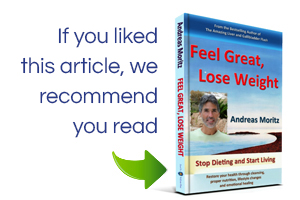By Andreas Moritz
The detrimental consequences of strenuous workouts
Don’t drastic weight-reduction plans produce dramatic results? What about all those people on television talk shows who lose, say, 20 pounds in 30 days or 100 pounds in 9 months? Yes, the results are certainly dramatic but what is not quite so publicly publicized is that about half the overweight individuals who subject themselves to such physical ‘abuse’ regain their lost weight in 12 months. Those who don’t, have to keep up the rigorous and punishing routines or risk putting it all back on.
Conventional weight-loss plans place a tremendous strain on the human body, prompting many to give up mid-way. Slacken the routine just a little and you gain the weight you lost by starving and sweating it out. This can be devastating and many individuals give up trying altogether. The message you are sending their body is: “It is impossible for me to lose weight. I am always going to be overweight.”
There are detrimental consequences of strenuous workouts such as long sessions of aerobics or endurance training. Why do so many overweight individuals regain the weight they shed when they stop working out? There is a fundamental flaw to exercising to the point of exhaustion – it burns fat, which is the wrong fuel! As shocking as that might sound, this is how it works at the physiological level. Extended workouts, or exercising for more than 20 minutes, releases cortisol, which in turn burns fat for fuel during the exercise session.
Since fat reserves are depleted, your body then synthesizes and stores more fat to replenish the depleted reserves in preparation for the next workout. With every successive workout, the fat-burning-fat storing cycle is further established till the body learns that it must make and store more fat every time some is burned. Hence, long and punishing workouts actually make the body store fat. That doesn’t seem to be a problem as long as you keep on exercising and burning the fat that builds up. Slow down a little and weight gain sets in.
A healthy alternative – PACE It Out
A healthy alternative is interval training. Going by the rather formidable term ‘Progressively Accelerating Cardiopulmonary Exertion’ or simple PACE, this means engaging in very short bursts of intense exercise followed by a very short period of rest and recovery.
Choose an exercise that suits you – like jogging, spot running, skipping or using an exercise bike. Engage in a short, intense burst of exercise lasting for no more than 30 seconds, then stop and rest for two minutes. Repeat this four times and you’re done exercising for the day – in eight minutes flat!
Now repeat this three to four times a week and not only will you lose weight, you will feel revitalized, rejuvenated and invigorated with an enhanced cardiovascular capacity, and lean and strong muscles, among many other health benefits.
How does interval training or PACE work at the physiological level? Why doesn’t it cause the same devastating effects as aerobic exercise?
When you exercise in short bursts, your body burns carbohydrates in the form of stored glycogen stored in the muscles and liver. It doesn’t burn fat during the session. After each session, it starts burning fat to replenish the depleted glycogen from your muscles and liver which were used during your training session.
Your body then continues to metabolize and burn fat for the next 24 hours after your interval training session. Your body thus learns that it does not have to store fat only to burn it again during a rigorous workout but that it must slowly burn fat to replenish depleted glycogen reserves. This is called afterburn, a magical and automatic process you can in motion by simply tweaking the type of exercise!
And in case it didn’t strike you – do the math and you’ll realize you need to exercise for quite literally less than 10 minutes a day! How’s that for people who are pressed for time?
This is an excerpt from Andreas Moritz‘s book Feel Great, Lose Weight.
You may share or republish this article provided you clearly mention the name of Andreas Moritz and paste a hyper link back to the post.

